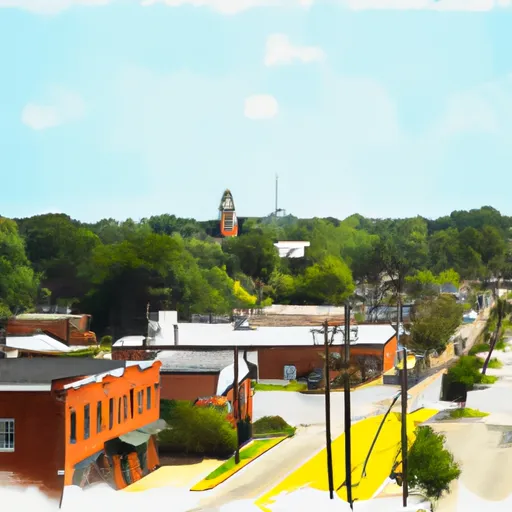-
 Snoflo Premium
Snoflo Premium
Get unlimited access to all our content
With no Ad interruptions! - Start Your Free Trial Login with existing account
Trenton
Eden Index
Climate
7.4
•
Recreation
5.5
•
Community
2.2
•
Safeguard
5.4/10

Trenton, Georgia is a small town located in the northwest part of the state. The climate in Trenton is classified as humid subtropical, characterized by hot and humid summers, mild winters, and ample rainfall throughout the year. Summers in Trenton can be quite hot, with temperatures often reaching the 90s°F (30s°C), while winters are generally mild, with temperatures averaging in the 40s°F (single digits °C).
The hydrology constituents in Trenton are diverse, with the town being close to several rivers and creeks, including Lookout Creek and McLemore Cove. These water bodies provide opportunities for fishing, kayaking, and canoeing, allowing residents and visitors to immerse themselves in nature and enjoy the scenic beauty of the area.
Trenton also offers numerous outdoor recreation opportunities. The nearby Cloudland Canyon State Park is a popular destination for hiking, camping, and rock climbing. With its stunning waterfalls, breathtaking views from the canyon rim, and miles of trails, outdoor enthusiasts can indulge in activities such as mountain biking, horseback riding, and geocaching. Overall, Trenton, Georgia provides a favorable climate, ample access to water bodies, and exciting outdoor activities for nature lovers to enjoy.
What is the Eden Index?
The Snoflo Eden Index serves as a comprehensive rating system for regions, evaluating their desirability through a holistic assessment of climate health, outdoor recreation opportunities, and natural disaster risk, acknowledging the profound impact of these factors on livability and well-being.
Climate Health Indicator (CHI): 7.4
Trenton receives approximately
1482mm of rain per year,
with humidity levels near 85%
and air temperatures averaging around
15°C.
Trenton has a plant hardyness factor of
7, meaning
plants and agriculture in this region tend to thrive during the non-winter months.
By considering the ideal temperature range, reliable water supplies, clean air, and stable seasonal rain or snowpacks, the Climate Health Indicator (CHI) underscores the significance of a healthy climate as the foundation for quality living.
A healthy climate is paramount for ensuring a high quality of life and livability in a region, fostering both physical well-being and environmental harmony. This can be characterized by ideal temperatures, reliable access to water supplies, clean air, and consistent seasonal rain or snowpacks.
Weather Forecast
Streamflow Conditions
Middle Tennessee-Hiwassee
Area Rivers
Middle Tennessee-Hiwassee
Snowpack Depths
Middle Tennessee-Hiwassee
Reservoir Storage Capacity
Middle Tennessee-Hiwassee
Groundwater Levels
Recreational Opportunity Index (ROI): 5.5
The Recreational Opportunity Index (ROI) recognizes the value of outdoor recreational options, such as parks, hiking trails, camping sites, and fishing spots, while acknowledging that climate plays a pivotal role in ensuring the comfort and consistency of these experiences.
Access to outdoor recreational opportunities, encompassing activities such as parks, hiking, camping, and fishing, is crucial for overall well-being, and the climate plays a pivotal role in enabling and enhancing these experiences, ensuring that individuals can engage in nature-based activities comfortably and consistently.
Camping Areas
| Campground | Campsites | Reservations | Toilets | Showers | Elevation |
|---|---|---|---|---|---|
| Coleman Lake Rec Area | 147 | 1,182 ft | |||
| Marion County Park | None | 645 ft | |||
| Pine Glen | 31 | 990 ft | |||
| Big Oak Gap Hunter Camp | 10 | 1,404 ft | |||
| James H Sloppy Floyd State Park | None | 720 ft | |||
| Foster Falls | 26 | 1,780 ft | |||
| Shellmound - Nickajack Dam Reservation | None | 678 ft | |||
| Cloudland Canyon State Park | None | 1,847 ft | |||
| De Soto State Park | 94 | 1,477 ft | |||
| Chewacla State Park | None | 516 ft |
Nearby Ski Areas
Catastrophe Safeguard Index (CSI):
The Catastrophe Safeguard Index (CSI) recognizes that natural disaster risk, encompassing floods, fires, hurricanes, and tornadoes, can drastically affect safety and the overall appeal of an area.
The level of natural disaster risk in a region significantly affects safety and the overall livability, with climate change amplifying these risks by potentially increasing the frequency and intensity of events like floods, fires, hurricanes, and tornadoes, thereby posing substantial challenges to community resilience and well-being.
Community Resilience Indicator (CRI): 2.2
The Community Resilience Indicator (CRI) recognizes that education, healthcare, and socioeconomics are crucial to the well-being of a region. The CRI acknowledges the profound impact of these elements on residents' overall quality of life. By evaluating educational resources, healthcare accessibility, and economic inclusivity, the index captures the essential aspects that contribute to a thriving community, fostering resident satisfaction, equity, and social cohesion.

